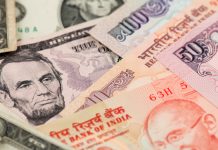- Indian Rupee (INR) falls after weak China PMI data
- China manufacturing activities contracted
- US Dollar (USD) rises better than expected consumer confidence
- Fed rate decision is due tomorrow
The US Dollar Indian Rupee (USD/INR) exchange rate is rising after mild losses yesterday. The pair rose -0.02% in the previous session, settling on Monday at 83.25. At 21:00 UTC, USD/INR trades +0.09% at 83.32 and trades in a range of 83.23 to 83.35.
The Indian Rupee falls, along with its Asian currency peers, came under pressure on Tuesday after weaker-than-expected Chinese data. China’s manufacturing PMI fell to 49.5, dropping below the 50 level separating expansion from contraction. Meanwhile, the non-services PMI showed growth slowed considerably to 50.5 from 51.7 in September. China is one of India’s largest trading partners.
The US Dollar is rising across the board. The US Dollar Index, which measures the greenback versus a basket of major currencies, trades at +0.53% at the time of writing at 106.73, snapping a 2-day losing trend.
The dollar pushed higher as U.S. data continued to come through stronger than expected ahead of tomorrow’s Federal Reserve interest rate decision.
Today, attention was on U.S. consumer confidence, which fell for a third straight month in October dipping to 102.6 from an upwardly revised 104.3 in September. This was still above the 100 level that analysts forecast.
The data suggests that Americans are losing confidence in the economic outlook as consumer confidence drops to its second-lowest level this year.
Concerns over the political situation as well as higher interest rates for longer we’re impacting consumers views on the economy.
Attention is now turning to the Federal Reserve’s interest rate decision which will be announced tomorrow. The US central bank is widely expected to leave interest rates unchanged at 5.25 to 5.5%
However, investors will be watching the press conference closely for any clues over the likely head of the Federal Reserve raising interest rates again this year particularly in light of the recent stronger than expected U.S. economic data.





